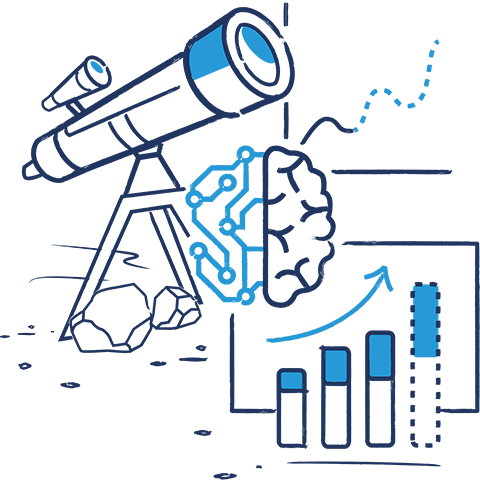Predictive analytics on time series

In today’s digital society, significant quantities of data are being generated at an unprecedented rate, e.g., in health care, energy, or manufacturing. The omnipresence of sensors and connectivity generates significant growth in the complexity of data and offers the potential for a revolutionary transformation. So far, the analysis of data streams coming from sensors and mobile devices is still underexplored and offers a lot of exciting opportunities to enrich systems and make them smarter by running data-driven applications.
Predictive analytics is considered to be one of the key drivers of innovation in the working of such systems. It aims to identify and extract relevant features or patterns from time series data, with the aim of predicting certain outcomes of interest. It lies at the intersection of various interrelated disciplines of computer engineering, such as data modeling, statistics, machine learning, artificial intelligence, deep learning, and data mining. Many systems can greatly benefit from the insights and actionable knowledge that can be extracted from their data, such as, e.g., events, anomalies, and forecasts.
As machine learning models are being incorporated into a workflow, it is often desirable that the models can explain why a certain prediction was made. Therefore, the interpretability of such models is becoming an additional baseline requirement. Furthermore, it is important to have reliable estimates of the uncertainty of predictions, especially when dealing with unobserved variables, incorrect model assumptions, and noisy or imprecise data.
Application areas:
- Health care

- Sensor readings provide essential information for a wide range of medical applications. The amount of data to be analyzed grows quickly and human-based analysis is a time-consuming task. To aid in this process, automated deep learning methods are being investigated to improve classification accuracy and interpretability.
- Energy

- The increase in computational power combined with advanced modeling and data analytics tools makes it possible to derive new technological solutions that can monitor residential energy consumption in households. Such solutions can provide valuable information to implement energy saving measures and to reduce the emission of greenhouse gases.
- Manufacturing

-
Many industrial processes rely on time-based and hands-on maintenance of equipment, despite recent advancements in predictive maintenance. By embedding sensors on different components, early signs of degradation that indicate the onset of breakdowns and failures may be detected. Predictive maintenance strategies can help to avoid downtime of equipment, the cost of unnecessary replacements, while improving process efficiency, safety and availability.
Selected use-cases:
- Sleep apnea
- Sleep apnea is one of the most common sleep disorders. It is characterized by pauses in the breathing, or shallow breathing during the sleep. A novel home monitoring solution was developed by combining new imec hardware innovations and state-of-the-art deep learning algorithms [1]-[2]. The imec device measures bio-impedance of the chest, which provides a more accurate estimation of both respiratory flow and effort, as compared to existing solutions that work with indirect measurements. This raw bio-impedance data is then filtered and analyzed using advanced deep-learning algorithms (such as LSTM’s), that are able to learn features and capture temporal dependencies in the data. This makes it possible to achieve a more reliable detection of sleep apnea events. The solutions that were previously developed are patented and valorized through the imec spin-off Onera Health.
Press release: Wearable Patch Uses Machine Learning to Detect Sleep Apnea, IEEE Spectrum, 2020
Patent: WO Patent, 2019/179836 (A1), PCT/EP2019/056222, 2018-03-19.
- Non-intrusive load monitoring
- Non-intrusive load monitoring methods aim to disaggregate the total power consumption of a household into individual appliances by analyzing changes in the voltage and current measured at the grid connection point of the household. The goal is to identify the active appliances, based on their unique fingerprint. By disaggregating the per-appliance energy consumption, adequate measures can be implemented to improve energy efficiency and to reduce the ecological footprint. Several new solutions were devised for robust detection of switching events, accurate appliance recognition, novel appliance identification and uncertainty quantification of the models. An extension of the PLAID dataset was released in collaboration with researchers from Carnegie Mellon University [3]-[8].
- Anomaly detection
-
Anomalies are events that do not conform to the normal or expected behavior of a process. Their correct detection can be useful as it may uncover events of interest. Traditional algorithms use statistical approaches to find extreme values or correlation changes between features. Several robust, domain-agnostic, and computationally efficient approaches were developed for the detection of anomalies, and validated on manufacturing and signal integrity applications [9]-[11].
Related research projects:
- EU H2020 AUTOWARE: “Wireless Autonomous, Reliable and Resilient ProductIon Operation ARchitecture for Cognitive Manufacturing”
- EU H2020 Z-BRE4K: “A novel predictive maintenance platform to eliminate unexpected-breakdowns and extend the life of production systems”
- SBO HYMOP: “HYMOP: Hypermodelling strategies on multi-stream time-series data for operational optimization”
- ICON SENCOM: “Smart energy consumption in manufacturing”
- ICON ELITE: “Efficiency-optimized production Lines using industrial Internet of Things Enhancements”
- ICON HIPS: “Coordinating and optimizing hospitals’ patient, medical supply and information flows”
- ICON MonieFlex: “Optimizing Monetization of Industrial Energy Flexibility in process industry”
- FWO project: “Incorporating error control in sparse modelling"
- Various bilateral and R&D projects with industrial partners in Flanders and beyond
Key publications:
[1] T. Van Steenkiste, W. Groenendaal, P. Dreesen, S. Lee, S. Klerckx, R. De Francisco, D. Deschrijver, T. Dhaene, "Portable Detection of Apnea and Hypopnea Events using Bio-Impedance of the Chest and Deep Learning", IEEE Journal of Biomedical and Health Informatics, vol. 29, no. 9, pp. 2589-2598, September 2020.
[2] T. Van Steenkiste, W. Groenendaal, D. Deschrijver, T. Dhaene, "Automated Sleep Apnea Detection in Raw Respiratory Signals using Long Short-Term Memory Neural Networks" IEEE Journal of Biomedical and Health Informatics, vol. 23, no. 6, pp. 2354-2364, November 2019.
[3] L. Werthen-Brabants, T. Dhaene, D. Deschrijver, "Uncertainty Quantification for Appliance Recognition in Non-Intrusive Load Monitoring using Bayesian Deep Learning", Energy and Buildings, vol. 270, 112282, September 2022.
[4] R. Medico, L. De Baets, J. Gao, S. Giri, E. Kara, T. Dhaene, C. Develder, M. Bergés, D. Deschrijver, "A Voltage and Current Measurement Dataset for Plug Load Appliance Identification in Households", Scientific Data, Nature, vol. 7, art. no. 49, 2020.
[5] L. De Baets, C. Develder, T. Dhaene, D. Deschrijver, "Detection of Unidentified Appliances in Non-Intrusive Load Monitoring Using Siamese Neural Networks", Electrical Power and Energy Systems, vol. 104, pp. 645-653, January 2019.
[6] L. De Baets, J. Ruyssinck, C. Develder, T. Dhaene, D. Deschrijver, "Appliance Classification using VI Trajectories and Convolutional Neural Networks", Energy and Buildings, vol. 158, pp. 32-36, January 2018.
[7] N. Sadeghianpourhamami, J. Ruyssinck, D. Deschrijver, T. Dhaene, C. Develder, "Comprehensive Feature Selection for Appliance Classification in NILM", Energy and Buildings, vol. 151, pp. 98-106, September 2017.
[8] L. De Baets, J. Ruyssinck, C. Develder, T. Dhaene, D. Deschrijver, "On the Bayesian Optimization and Robustness of Event Detection Methods in NILM", Energy and Buildings, vol. 145, pp. 57-66, June 2017.
[9] D. Nieves Avendano, D. Caljouw, D. Deschrijver, S. Van Hoecke, "Anomaly Detection and Event Mining in Cold Forming Manufacturing Processes", International Journal of Advanced Manufacturing Technology, https://doi.org/10.1007/s00170-020-06156-2, October 2020.
[10] R. Medico, D. Spina, D. Vande Ginste, D. Deschrijver, T. Dhaene, "Machine-Learning-Based Error Detection and Design Optimization in Signal Integrity Applications", IEEE Transactions on Components, Packaging and Manufacturing Technology, vol. 9, no. 9, pp. 1712-1720, September 2019.
[11] R. Medico, N. Lambrecht, H. Pues, D. Vande Ginste, D. Deschrijver, T. Dhaene, D. Spina, "Machine Learning Based Error Detection in Transient Susceptibility Tests", IEEE Transactions on Electromagnetic Compatibility, vol. 61, no. 2, pp. 352-360, April 2019.